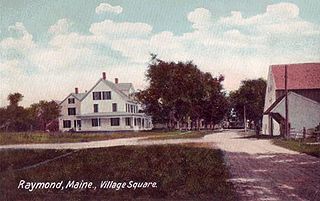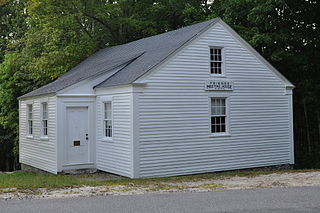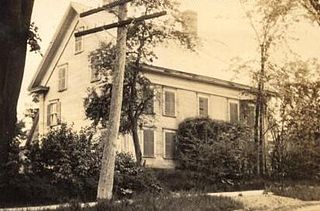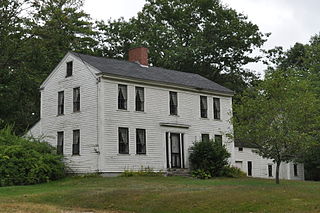
Casco is a town in Cumberland County, Maine, United States. The population was 3,646 at the 2020 census. Casco includes the villages of Casco, South Casco and Cook Mills. The town borders the east shore of Sebago Lake, and is home to part of Sebago Lake State Park. Casco is part of the Portland–South Portland–Biddeford, Maine metropolitan statistical area. Casco is just under 30 miles (48 km) from downtown Portland.

Raymond is a town in Cumberland County, Maine, United States. The population was 4,536 at the 2020 census. It is a summer recreation area and is part of the Portland–South Portland–Biddeford, Maine metropolitan statistical area. Raymond Neck is the landing for the ferry to the town of Frye Island in Sebago Lake. The Raymond school system is currently affiliated with the Windham school system in a district known as RSU 14.

Abraham Lincoln Birthplace National Historical Park is a designated U.S. historic park preserving two separate farm sites in LaRue County, Kentucky, where Abraham Lincoln was born and lived early in his childhood. He was born at the Sinking Spring site south of Hodgenville and remained there until the family moved to the Knob Creek Farm northeast of Hodgenville when he was two years old, living there until he was seven years of age. The park's visitor center is located at the Sinking Spring site.

The History of Portland, Maine begins when the area was called Machigonne, meaning "great neck," by Algonquians who originally inhabited the peninsula. It extends to the city's recent cultural and economic renaissance.

The Woodrow Wilson Boyhood Home is a historic house museum at 419 7th Street in Augusta, Georgia. Built in 1859, it was a childhood home of Woodrow Wilson (1856–1924), the 28th president of the United States and proponent of the League of Nations. The house is owned and operated by Historic Augusta, Inc., and was designated a National Historic Landmark on October 6, 2008.

The East Raymond Union Chapel is a historic chapel at 394 Webbs Mills Road in East Raymond, Maine. Built in 1890, it is a modest wood-frame building with Queen Anne and Gothic Revival styling. It has served as a non-denominational religious meeting place for much of its time; it is now affiliated with the United Church of Christ and the Casco Village Church in Casco. It has scheduled services during the summer. The building was listed on the National Register of Historic Places in 2004.

Friends Meetinghouse is a historic Quaker meeting house on Quaker Ridge Road in Casco, Maine. Built in 1814, it is the oldest surviving Quaker meeting house in the state. It was listed on the National Register of Historic Places in 1975.

The Bell Hill Meetinghouse is a historic church building located at 191 Bell Hill Road in Otisfield, Maine. The building was the work of local master builder Nathan Nutting Jr. (1804-1867), having since remained a significant example of transitional Federal-Greek Revival architecture. It was listed on the National Register of Historic Places in 2003 to ensure its preservation.
Hawthorne House may refer to:

The Nathaniel Dyer House is an historic house at 168 York Street in Portland, Maine. Built in 1803, it is one of the city's oldest surviving brick houses, rare for the building material and for its scale, which is for a middle-class family of the period. The house was listed on the National Register of Historic Places in 1987.

The Jug Tavern, also known as the Davids–Garrison House or the Grapevine Inn, is located at the junction of Revolutionary Road and Rockledge Avenue in Sparta section of Ossining, New York, United States. It is a wood frame building, the oldest elements of which date to the mid-18th century, before the American Revolution, making it possibly the oldest structure in the village. It has, however, been expanded and modified since then, and was almost completely rebuilt in the late 19th century. In 1976 it was listed on the National Register of Historic Places.

The Blackhawk Putnam Tavern is an historic house at 22 North Street in Houlton, Maine, United States. Built in 1813, it is the oldest standing building Aroostook County. In the mid-19th century it served as a tavern on the military road, and one of its owners was Blackhawk Putnam, a veteran of the American Civil War. It was listed on the National Register of Historic Places on January 30, 1976.

Mechanics' Hall is a historic building and meeting space at 519 Congress Street in downtown Portland, Maine. Built in 1857-59 by and for the members of the Maine Charitable Mechanic Association, it is a well-preserved example of Italianate architecture executed in brick and stone, and a landmark of Portland's downtown business and arts district. It was listed on the National Register of Historic Places in 1973. The building, still owned by MCMA, houses the association's library. The Maine Charitable Mechanic Association was founded in 1815 as a social organization that promoted and supported the skilled trades and their practitioners. Its original members were master craftspeople and entrepreneurs and their apprentices.

The Watkins House and Cabins are a history property at the junction of Raymond Cape Road and United States Route 302 in Casco, Maine. The property exemplifies the adaptive alteration and reuse of properties for different purposes over a 200-year period in southern Maine. The property is 13 acres (5.3 ha) in size, much of which is now woodland and pasture. The developed portion of the property includes two houses, one of which dates to the early 19th century, a barn, and three small cabins, as well as the remains of a carriage factory. The property was listed on the National Register of Historic Places in 1992.

The Richard Manning House is a historic house on Raymond Cape Road in South Casco, Maine. This well-preserved c. 1795 wood-frame house is an excellent example of Federal architecture. Hawthorne and his mother lived here while Hawthorne's boyhood home was being built by his uncle after his father's death at sea. It is further notable as one of the places where the writer Nathaniel Hawthorne spent some of his childhood years. Richard Manning, a native of Salem, Massachusetts, was Hawthorne's uncle, and the house is located not far from Hawthorne's boyhood home. The house was listed on the National Register of Historic Places in 1993.
Beckett's Castle is a historic summer house on Singles Road in Cape Elizabeth, Maine. A picturesque two-story stone building with a three-story tower, it was built in 1871-74 by Sylvester Beckett, a Portland lawyer and a major figure in the city's literary scene. It was listed on the National Register of Historic Places in 1974, for its association with Beckett, and for its distinctive Gothic architecture.
The Great Chebeague Golf Club is a country club at 16 Stone Wharf Road on Chebeague Island, Maine. It has a nine-hole golf course on more than 28 acres (11 ha) on the north side of the island. Its clubhouse is a repurposed circa 1807 residence, which is probably one of the oldest buildings used for that purpose in the nation. The club was listed on the National Register of Historic Places in 2015.

The Troy Meeting House, also known as the Troy Union Church, is a historic church at 514 Bangor Road in Troy, Maine. Built in 1840, it is a fine example of transitional vernacular Greek Revival-Gothic Revival architecture, and an enduring symbol of the religious life of the community. It was listed on the National Register of Historic Places in 2011.

The Tavern on Mutton Hill, also known locally as the 1812 Tavern, is a historic former public accommodation on Church Hill Road in Charlotte, Vermont. Built in 1813, it is a prominent local example of Federal period architecture, and the town's only documented 19th-century tavern house built out of brick. It was listed on the National Register of Historic Places in 1982.
The historical buildings and structures of Yarmouth, Maine, represent a variety of building styles and usages, largely based on its past as home to almost sixty mills over a period of roughly 250 years. These mills include that of grain, lumber, pulp and cotton. Additionally, almost three hundred vessels were launched by Yarmouth's shipyards in the century between 1790 and 1890, and the homes of master shipwrights and ship captains can still be found throughout the town.


















